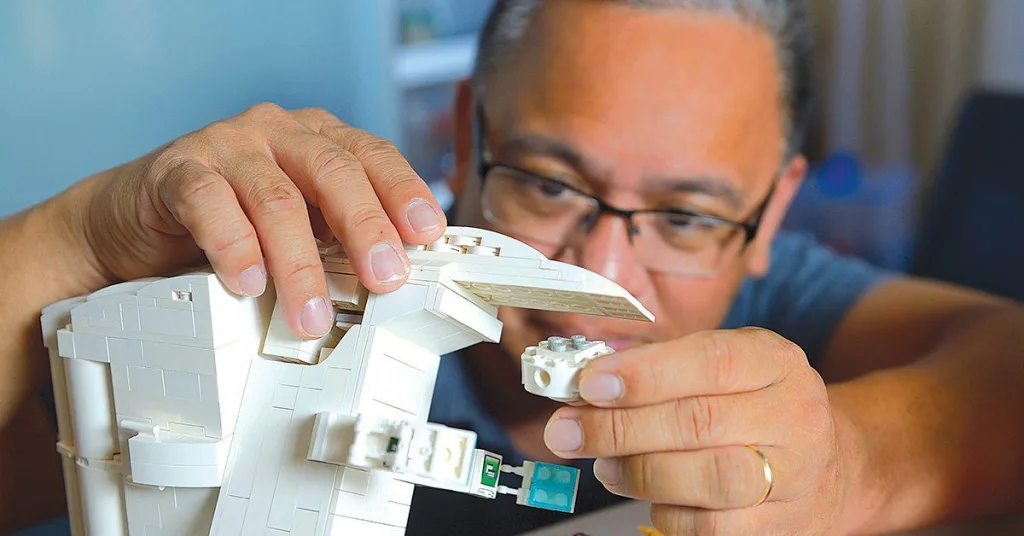At age 40, Victor Ty, RN, left a 20-year career in textiles and apparel design and technology to pursue a degree in nursing. After earning his associate's degree in less than two years, he became a staff nurse at the radiation oncology clinic at Maimonides Medical Center in Brooklyn, where he practices today, while also working toward his BSN. Surprisingly, Ty learned to integrate the skills he gained in his former career into his nursing career. "Because I sew and knit, I've done everything from customizing trach covers to showing patients how to loom knit while they wait for their radiation treatment," he said. "My life experiences definitely help me to be versatile when meeting my patients' needs." What some people don't know about Ty is his love of Legos. From cars and trains to tennis rackets and even buildings, he has been creating with Lego bricks for most of his life. An electronics/communications engineer during his undergraduate years and a dBaseIII+ programmer, he describes himself as "a tinkerer who enjoys taking things apart and putting them back together."
A creation is born
During his first year as a nurse, Ty cared for a pediatric patient with autism and developmental disabilities who had been diagnosed with lymphoma. During his initial meeting with the young man and his family, Ty discovered his patient loved Legos. "I immediately thought of building a Lego model of the radiation machine, also known as the Lego Linear Accelerator or linac, to help him understand the mechanics of his treatment," Ty said. "It became a bridge to our communication." He created a model with moving parts, including the gantry, onboard imaging and couch. Made completely out of his own Lego brick sets, it was a tangible and far less intimidating structure compared with the actual machine that occupies an entire room, Ty said. More importantly, it helped create a connection between nurse and patient. "I was able to effectively communicate with my patient, and I am proud to say he completed his radiation therapy regimen without any interruptions." Besides their mutual enjoyment of Legos, Ty had something else in common with his patient. Ty's older son, Nicholas, has autism, and he called upon his own personal experiences when helping and educating this young man. Ty's son also was the reason he became a nurse. After witnessing how perplexed healthcare providers were when assessing the needs of children with autism, Ty pursued a nursing degree and then began serving on a task force that identified deficits of community providers who work with individuals with developmental disabilities. He plans to earn a doctoral degree in nursing with a focus on data management, informatics and public health. Ty also hopes to help establish organizational policies addressing the needs of the developmentally disabled population.
It doesn't end there
In May 2014, Maimonides Medical Center was the first hospital in the country to host a Mini Maker Faire, showcasing nursing innovations and inventions. Because of Ty's aptitude for creativity, Kelly Reilly, MSN, RN-BC, CHSE, director of nursing for research, EBP and education at Maimonides, invited Ty to help organize the Mini Maker Faire, where he showcased the Lego Linear Accelerator. "Maker Nurse has been instrumental in increasing the awareness of the innovative spirit of nurses all over the U.S.," Ty said. "I was pleased they showcased the Lego Linear Accelerator, the MRI model and other medical models of imaging machines I created at their World Maker Faire in New York City for the past three years." In September 2015, he was featured as a Maker Nurse by MakerCon, an organization supporting inventions, and Lego recognized Ty as a Lego Maker in August 2015, awarding him a prototyping prize for the Lego Linear Accelerator. Today, New York University Langone Medical Center is using Ty's original prototype in its radiation oncology department. And other hospitals in the tri-state area have shown an interest in the model, he said. Always up for a challenge, Ty recently came up with his newest iteration of the linear accelerator, using the Lego Mindstorms EV3 robotic system. His younger son, Benjamin, who is 12, is collaborating with him to complete a programmable linear accelerator so the model will move in a similar fashion to the actual accelerator. "Benjamin, using a computer program by Lego, will program the angles of the gantry [the part of the machine that emits radiation] based on the prescription of the physician," said Ty. "He can duplicate the movements on the Lego model to show the patient the position of the gantry at any point during their treatment." Ty has continued to design models of other imaging and radiation machines such as the MRI, CT, proton beam and high dose afterloader. His MRI model is being used by the child life specialist team at Maimonides, helping children to become familiar with the machine so they are less fearful and will not need to be sedated during the procedure. Along with the model, the team has incorporated sound effects and a PowerPoint presentation, which are shown to the children and family prior to the procedure. As a result of their efforts, the team has convinced about 50 children to forego sedation, resulting in less risk to the child and a family savings in anesthesia costs, Ty said.
Words of wisdom
Ty shares some words of wisdom for those who are considering creating something in nursing practice. "As nurses, I think we possess an inherent knack for identifying and solving problems. If you have a solution for a complex dressing or something to make your work more efficient, share it with your nursing community," he said. "Collaborate and empower nurses to step up and create solutions to our practical and real problems at the bedside or in an ambulatory setting." o Photo by David DeBalko.






